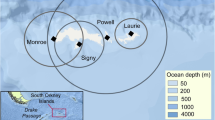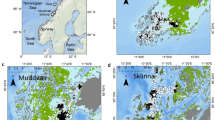Abstract
Long-term studies are essential to determine demographic parameters and population trends in seabirds. However, studies to date have focused mainly on the larger and accessible species. While small seabirds (< 200 g) play a major role in marine ecosystems, their nesting habitat, which is typically fragile convoluted burrows, largely preclude long-term surveys. This study evaluated the installation of artificial burrows as a tool to facilitate ongoing long-term research on small burrowing seabirds. We tested the use and acceptance of artificial burrows during the chick-rearing period of common diving petrels (Pelecanoides urinatrix) on Mayes Island, Kerguelen Archipelago, southern Indian Ocean. The growth rate, mass at fledging and fledging rate of chicks were similar between artificial and natural burrows. Similarly, there was no difference in occupancy rate 1 and 2 years after artificial burrows were installed. The installation of artificial burrows during the chick-rearing period of a small burrowing seabird appears to be an effective way to facilitate ongoing monitoring and research and, therefore, we recommend the wider use of artificial burrows to facilitate monitoring and research of other small burrow-nesting procellariiform species.


Similar content being viewed by others
References
Ambagis J (2004) A comparison of census and monitoring techniques for Leach’s storm petrel. Waterbirds 27:211–215
Barbraud C, Delord K (2006) Population census of blue petrels Halobaena caerulea at Mayes Island, Iles Kerguelen. Antarct Sci 18:199–204
Barbraud C, Delord K, Marteau C, Weimerskirch H (2009) Estimates of population size of white-chinned petrels and grey petrels at Kerguelen Islands and sensitivity to fisheries. Anim Conserv 12:258–265
Barbraud C, Rivalan P, Inchausti P, Nevoux M, Rolland V, Weimerskirch H (2011) Contrasted demographic responses facing future climate change in Southern Ocean seabirds. J Anim Ecol 80:89–100
Barbraud C, Weimerskirch H (2003) Climate and density shape population dynamics of a marine top predator. Proc R Soc Lond B 270:2111–2116
Berrow SD (2000) The use of acoustics to monitor burrow-nesting white-chinned petrels Procellaria aequinoctialis at Bird Island, South Georgia. Polar Biol 23:575–579
Blackmer AL, Ackerman JT, Nevitt GA (2004) Effects of investigator disturbance on hatching success and nest-site fidelity in a long-lived seabird, Leach’s storm-petrel. Biol Conserv 116:141–148
Bocher P, Cherel Y, Hobson KA (2000) Complete trophic segregation between South Georgian and common diving petrels during breeding at Iles Kerguelen. Mar Ecol Prog Ser 208:249–264
Bolton M, Medeiros R, Hothersall B, Campos A (2004) The use of artificial breeding chambers as a conservation measure for cavity-nesting Procellariiform seabirds: a case study of the Madeiran storm petrel (Oceanodroma castro). Biol Conserv 116:73–80
Bonadonna F, Cunningham GB, Jouventin P, Hesters F, Nevitt GA (2003) Evidence for nest-odour recognition in two species of diving petrel. J Exp Biol 206:3719–3722
Bourgeois K, Dromzée S, Vidal E (2015) Are artificial burrows efficient conservation tools for seabirds? A case study of two sympatric shearwaters on neighbouring islands and guidelines for improvement. Biol Conserv 191:282–290
Brooke M (2004) Albatrosses and petrels across the world. Oxford University Press, Oxford
Carey MJ (2009) The effects of investigator disturbance on Procellariiform seabirds: a review. N Z J Zool 36:367–377
Chapuis JL, Frenot Y, Lebouvier M (2002) Une gamme d’iles de référence, un atout majeur pour l’évaluation de programmes de restauration dans l’archipel de Kerguelen. Rev Ecol (Terre Vie) 9:121–130
Croxall JP, Butchart SHM, Lascelles B, Stattersfield AJ, Sullivan B, Symes A, Taylor P (2012) Seabird conservation status, threats and priority actions: a global assessment. Bird Conserv Int 22:1–36
Cunningham GB, Van Buskirk RW, Hodges M, Nevitt GA (2012) Responses of common diving petrel chicks (Pelecanoides urinatrix) to burrow and colony specific odours in a simple wind tunnel. Antarct Sci 24:337–341
Cuthbert RJ (2001) Conservation and ecology of Hutton's shearwater (Puffinus huttoni). Conservation advisory services notes no 335. Department of Conservation, Wellington
Cuthbert R, Davis LS (2002) Adult survival and productivity of Hutton’s shearwaters. Ibis 144:423–432
Dilley BJ, Davies D, Bond AL, Ryan PG (2015) Effects of mouse predation on burrowing petrel chicks at Gough Island. Antarct Sci 27:543–553
Eizenberg YH (2019) Breeding biology of sympatric fairy prions (Pachyptila turtur) and common diving petrels (Pelecanoides urinatrix) in northern Bass Strait. Deakin University, Melbourne
Fischer JH, Chambon J, Debski I, Hiscock JA, Cole R, Taylor GA, Wittmer HU (2018) Buffering artificial nest boxes for Procellariiformes breeding in exposed habitats: investigating effects on temperature and humidity. Notornis 65:35–41
Fischer JH, Debski I, Taylor GA, Wittmer HU (2017) Assessing the suitability of non-invasive methods to monitor interspecific interactions and breeding biology of the South Georgian diving petrel (Pelecanoides georgicus). Notornis 64:13–20
Frenot Y, Gloaguen JC, Massé L, Lebouvier M (2001) Human activities, ecosystem disturbance and plant invasions in subantarctic Crozet, Kerguelen and Amsterdam Islands. Biol Conserv 101:33–50
Fromant A, Schumann N, Dann P, Cherel Y, Arnould JPY (2020) Trophic niches of a seabird assemblage in Bass Strait, south-eastern Australia. PeerJ 8:e8700. https://doi.org/10.7717/peerj.8700
Gaston AJ (1996) A nest box for ancient murrelets. Colon Waterbirds 19:116–120
Guinet C, Cherel Y, Ridoux V, Jouventin P (1996) Consumption of marine resources by seabirds and seals in Crozet and Kerguelen waters: changes in relation to consumer biomass 1962–1985. Antarct Sci 8:23–30
Gummer H, Taylor G, Wilson KJ, Rayner M (2015) Recovery of the endangered Chatham petrel (Pterodroma axillaris): a review of conservation management techniques from 1990 to 2010. Glob Ecol Conserv 3:310–323
Huntington CE, Butler RG, Mauk RA (1996) Leach’s storm-petrel. In: Poole A, Gill F (eds) The Birds of North America. The Academy of Natural Sciences/American Ornithologist Union, Philadelphia PA/Washington DC
Heerah K, Dias MP, Delord K, Oppel S, Barbraud C, Weimerskirch H, Bost CA (2019) Important areas and conservation sites for a community of globally threatened marine predators of the Southern Indian Ocean. Biol Conserv 234:192–201
Lavers JL (2015) Population status and threats to flesh-footed shearwaters (Puffinus carneipes) in South and Western Australia. ICES J Mar Sci 72:316–327
Libois E, Gimenez O, Oro D, Mínguez E, Pradel R, Sanz-Aguilar A (2012) Nest boxes: a successful management tool for the conservation of an endangered seabird. Biol Conserv 155:39–43
Lyver P, Hamilton S, McKenzie M, Dickson I, Dooher M, Broad T, Moller H (1998) A burrow scope for examining petrel nests in burrows. Conservation advisory science notes no 209. Department of Conservation, Wellington
MacKenzie DI, Nichols JD, Royle JA, Pollock KH, Bailey LL, Hines JE (2006) Occupancy estimation and modeling: inferring patterns and dynamics of species occurrence. Academic Press, San Diego
Marchant S, Higgins PJ (1990) Handbook of Australian, New Zealand and Antarctic birds, vol 1. Oxford University Press, Melbourne
Marks JS, Leasure SM (1992) Breeding biology of Tristram’s storm-petrel on Laysan Island. Wilson Bull 104:719–731
McKechnie S, Fletcher D, Moller H, Scott DS, Newman J, Bragg C (2007) Estimating and correcting for bias in population assessments of sooty shearwaters. J Wild Manag 71:1325–1335
Miskelly CM, Sagar PM, Tennyson AJD, Scofield RP (2001) Birds of the Snares Islands, New Zealand. Notornis 48:1–40
Miskelly CM, Taylor GA, Gummer H, Williams R (2009) Translocations of eight species of burrow-nesting seabirds (genera Pterodroma, Pelecanoides, Pachyptila and Puffinus: Family Procellariidae). Biol Conserv 142:1965–1980
Mougeot F, Genevois F, Bretagnolle V (1998) Predation on burrowing petrels by the brown skua (Catharacta skua lönnbergi) at Mayes Island, Kerguelen. J Zool 244:429–438
Mougin JL, Jouanin C, Roux F (2002) Inexperienced birds and breeding in the Cory's shearwater (Calonectris diomedea). J Ornithol 143:57–63
Pacoureau N, Gaget E, Delord K, Barbraud C (2019) Prey remains of brown skua is evidence of the long-term decline in burrow occupancy of blue petrels and thin-billed prions at Mayes Island, Kerguelen. Polar Biol 42:1873–1879
Parker GC, Rexer-Huber K (2016) Guidelines for designing burrowing petrel surveys to improve population estimate precision. Agreement on the Conservation of Albatrosses and Petrels. https://www.acap.aq/en/resources/acap-conservation-guidelines. Accessed 15 Oct, 2018
Payne MR, Prince PA (1979) Identification and breeding biology of the diving petrels Pelecanoides georgicus and P. urinatrix exsul at South Georgia. N Z J Zool 6:299–318
R Core Team (2019) R: a language and environment for statistical computing. R Foundation for Statistical Computing, Vienna
Ramos JA, Monteiro LR, Sola E, Moniz Z (1997) Characteristics and competition for nest cavities in burrowing Procellariiformes. Condor 99:634–641
Richards FJ (1959) A flexible growth function for empirical use. J Exp Bot 10:290–300
Richdale LE (1943) The white-faced storm petrel or takahi-kare-moana (Pelagadroma marina maoriana, Mathews). Part I. TP Roy Soc NZ 73:97–115
Richdale LE (1965) Biology of the birds of Whero Island, New Zealand, with special reference to the diving petrel and the white-faced storm petrel. T Zool Soc Lon 31:1–86
Roby DD (1989) Chick feeding in the diving petrels Pelecanoides georgicus and P. urinatrix exsul. Antarct Sci 1:337–342
Rodríguez A, Arcos JM, Bretagnolle V et al (2019) Future directions in conservation research on petrels and shearwaters. Front Mar Sci 6:94
Ropert-Coudert YR, Chiaradia A, Ainley D et al (2019) Happy Feet in a hostile world? The future of penguins depends on proactive management of current and predictable threats. Front Mar Sci 6:248
Ryan PG, Dorse C, Hilton GM (2006) The conservation status of the spectacled petrel Procellaria conspicillata. Biol Conserv 131:575–583
Schulz M, Robinson S, Gales R (2005) Breeding of the grey petrel (Procellaria cinerea) on Macquarie Island: population size and nesting habitat. Emu 105:323–329
Schumann N, Dann P, Hoskins AJ, Arnould JPY (2013) Optimizing survey effort for burrow-nesting seabirds. J Field Ornithol 84:69–85
Soanes LM, Thomas RJ, Bolton M (2012) Evaluation of field and analytical methods for estimating the population size of burrow-nesting seabirds from playback surveys. Bird Study 59:353–357
Taylor G, Cockburn S, Palmer D, Liddy P (2012) Breeding activity of Chatham Island taiko (Pterodroma magantae) using PIT tag recorders. N Z J Ecol 36:425–432
Thoresen AC (1969) Observations on the breeding behaviour of the diving petrel Pelecanoides u.urinatrix (Gmelin). Notornis 16:241–260
Warham J (1990) The petrels: their ecology and breeding systems. Academic Press, London
Waugh SM, Barbraud C, Adams L, Freeman AND, Wilson K-J, Wood G, Landers TJ, Baker GB (2015) Modeling the demography and population dynamics of a subtropical seabird, and the influence of environmental factors. Condor 117:147–164
Weimerskirch H, Zotier R, Jouventin P (1989) The avifauna of the Kerguelen Islands. Emu 89:15–29
Wilson UW (1986) Artificial rhinoceros auklet burrows: a useful tool for management and research. J Field Ornithol 57:295–299
Wooller RD, Bradley JS, Skira IJ, Serventy DL (1990) Reproductive success of short-tailed shearwaters Puffinus tenuirostris in relation to their age and breeding experience. J Anim Ecol 59:161–170
Acknowledgements
This study was funded by the French Polar Institute IPEV (Program IPEV 394 (resp. C.A Bost) & 109 (resp. H. Weimerskirch)), the latest being in charge of the long–term demographic research on Mayes Island. We thank the IPEV logistic staff (Y. Le Meur, N. Marchand, R. Bellec, and the Geners of the 66–67-68 missions on Kerguelen) for their support. We also warmly thank P. Denis who built the artificial burrows, and C. Barbraud and H. Weimerskirch for their useful comments of an early version of this article and statistical analysis. We acknowledge the pioneering development of artificial burrows for petrel conservation by Graeme Taylor, Helen Gummer and colleagues in New Zealand, used as the starting point for our burrow design.
Author information
Authors and Affiliations
Contributions
Study design: A.F., C.B., C.M.M. Data collection: A.F. Data analysis and processing: A.F. Writing: A.F., C.B., C.M.M, J.P.Y.A. All authors edited and revised the manuscript, gave final approval for publication and agreed to be held accountable for the content therein.
Corresponding author
Ethics declarations
Conflict of interest
All authors declare that they have no conflicts of interest.
Ethical approval
The study was in agreement with the ethical standards on animal experimentation in the Terres Australes et Antarctiques Françaises. It was fully approved by the French ethics committee for animal experimentation in the reserve of the French Southern and Antarctic lands.
Additional information
Publisher's Note
Springer Nature remains neutral with regard to jurisdictional claims in published maps and institutional affiliations.
Rights and permissions
About this article
Cite this article
Fromant, A., Miskelly, C.M., Arnould, J.P.Y. et al. Artificial burrows as a tool for long-term studies of diving petrels. Polar Biol 43, 435–442 (2020). https://doi.org/10.1007/s00300-020-02645-y
Received:
Revised:
Accepted:
Published:
Issue Date:
DOI: https://doi.org/10.1007/s00300-020-02645-y




